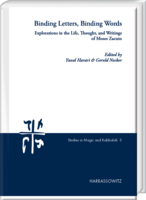|
|
more titles of the subject:
Download:
Binding Letters, Binding Words is devoted to the writings of one of the most prominent Lurianic kabbalists and an outstanding rabbinic figure of the seventeenth century, Rabbi Moses Zacuto (ca. 1610–1697). Zacuto’s life spanned nearly the entire century, and his work constitutes a vivid expression of its spirit, both in the Jewish sphere and within the broader cultural contexts that surrounded it. His literary and intellectual output extended across a wide range of genres: biblical commentary, homiletic writings, and halakhah; theosophical Kabbalah and the ritual praxis derived from it; poetry, drama, and riddles; and a vast and long-standing correspondence with his disciples as well as with Jewish communities in Italy and beyond. His imprint, however, is most clearly discernible in the realm of Kabbalah, where through his life and writings, he served as a bridge between old and new, East and West, thought and practice.
The studies gathered in this volume seek to illuminate central dimensions of Zacuto’s multifaceted oeuvre, with particular attention to his thought and creativity in the principal domains of Kabbalah: theoretical Kabbalah, practical Kabbalah, and the Kabbalah of divine names. The research underlying these studies is grounded in the discovery of sources hitherto unexamined by scholars, most of which remain in manuscript form, and in their careful consideration both in themselves and within their broader intellectual, social, and historical contexts. |






